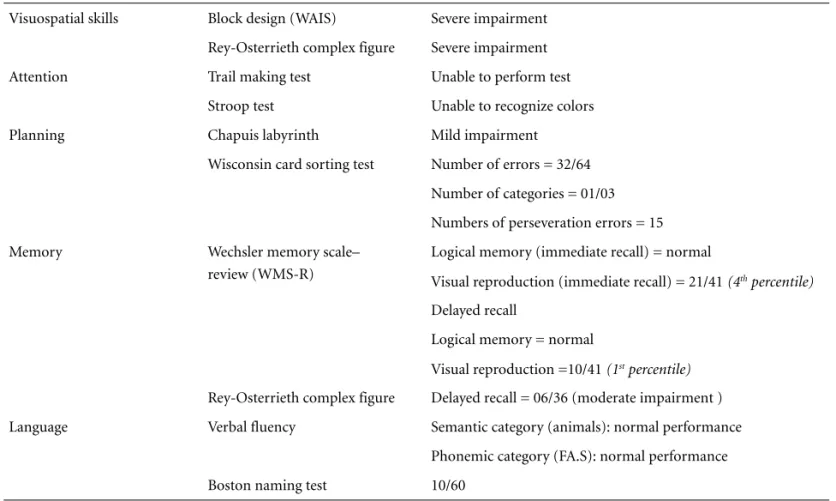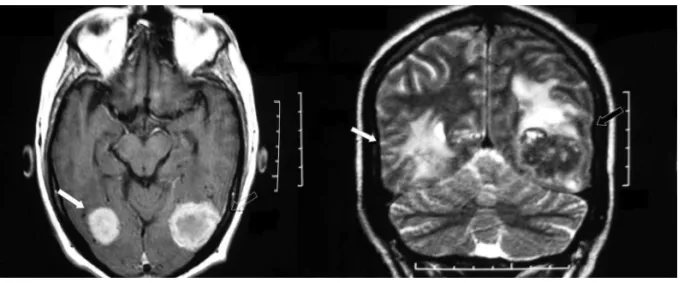Dementia &Neuropsychologia 2007;1:104-107
104
1MD, Department of Neurology, University of São Paulo School of Medicine, Behavioral and Cognitive Neurology Unit Fellow.2MD, Department of Neurology, University of São Paulo School of Medicine, Electroencephalography-Epilepsy Fellow;3MD, PhD, Behavioral and Cognitive Neurology Unit Psychology.4MD, PhD, Department of Neurosurgery, University of São Paulo School of Medicine;5MD, PhD, Department of Neurology, University of São Paulo School of Medicine;6MD, PhD, Behavioral and Cognitive Neurology Unit Faculty of Medicine, Federal University of Minas Gerais.
Dr. Norberto Anízio Ferreira Frota – Rua Dr. Nicolau de Sousa Queiros, 406 / Ap. 94 - 04105001 São Paulo SP - Brazil. E-mail: naffrota@yahoo.com.br.
Visual agnosia and prosopagnosia
secondary to melanoma metastases
Case report
Norberto Anízio Ferreira Frota
1, Lécio Figueira Pinto
2, Claudia Sellitto Porto
3,
Paulo Henrique Pires de Aguia
4, Luiz Henrique Martins Castro
5, Paulo Caramelli
6Abstract – The association of visual agnosia and prosopagnosia with cerebral metastasis is very rare. The presence of symmetric and bilateral cerebral metastases of melanoma is also uncommon. We report the case of a 34 year-old man who was admitted to hospital with seizures and a three-month history of headache, with blurred vision during the past month. A previous history of melanoma resection was obtained. CT of the skull showed bilateral heterogeneous hypodense lesions in the occipito-temporal regions, with a ring pattern of con-trast enhancement. Surgical resection of both metastatic lesions was performed after which the patient devel-oped visual agnosia and prosopagnosia. On follow-up, he showed partial recovery of visual agnosia, while prosopagnosia was still evident. The relevance of this case is the rare presentation of metastatic malignant melanoma affecting homologous occipito-temporal areas associated with prosopagnosia and associative visual agnosia.
Key words:prosopagnosia, visual agnosia, metastasis, melanoma.
Agnosia visual e prosopagnosia secundárias a melanoma metastático: relato de caso
Resumo – A associação de agnosia visual e prosopagnosia com metástase cerebral são muito raras. A presença de lesões metastáticas de melanoma, simétricas e bilaterais, também é incomum. Nós descrevemos o caso de um homem de 34 anos que foi admitido no hospital com convulsões e uma história de cefaléia há três meses, com dificuldade visual no último mês. História pregressa revelava ressecção de melanoma. TC de crânio evi-denciou lesões hipodensas, heterogêneas, bilaterais nas regiões occipito-temporais, com captação de contraste anelar. A ressecção cirúrgica de ambas as metástases cerebrais foi realizada e o paciente desenvolveu agnosia visual e prosopagnosia após o procedimento. Na evolução houve melhora parcial da agnosia visual enquanto a prosopagnosia ainda estava evidente. A relevância deste caso consiste na apresentação rara de melanoma maligno metastático afetando as áreas occipito-temporais homólogas associada com prosopagnosia e agnosia visual associativa.
Palavras-chave:prosopagnosia, agnosia visual, metastase, melanoma.
Visual agnosia is defined as a disorder of the visual process leading to dysfunction in perception and/or rec-ognition of objects, faces (prosopagnosia), letters (alexia) or colors (achromatopsia), either in isolation or
combi-nation1-4.
Prosopagnosia was defined by Bodamer in 1947, although it had been known since the XIX century, ac-cording to a description by Quaglino, Hughlings Jackson
and Charcot. It is associated with bilateral lesions in the fusiform gyrus, although unilateral lesions involving the
right fusiform gyrus have also been described5.
Ischemic lesions are the most frequent causes, but focal atrophy, congenital disorders and tumors can also
be associated with prosopagnosia1.
Dementia &Neuropsychologia 2007;1:104-107
105
most frequently encountered histologic type of brain metastasis. Occipital lobe lesions represent 5.5% of brain
metastasis5,6. Association with prosopagnosia has
previ-ously been described in only one patient7.
Case report
A 34 year-old man, a professional cook, with an edu-cational level of four years, presented a clinical history of headache, nausea and vomiting in the past three months. He also complained of a visual disorder described as a “reading difficulty” in the last month.
The patient was admitted to the emergency room because of a tonic-clonic seizure the day before. On ex-amination, the patient was confused and somnolent, but arousable, with reactive pupils and no motor deficits.
The magnetic resonance imaging (MRI) showed
bilateral occipito-temporal lesions suggestive of brain metastasis. These lesions, involved the medial and inferi-or occipital gyrus bilaterally, the left fusifinferi-orm and lingual gyrus and part of the right fusiform gyrus (Figure 1). Eight years before, the patient had undergone partial resection of a malignant melanoma in the nose, without further treatment.
Subsequently, he was submitted to a neurosurgical procedure involving total metastasis resection through occipital craniectomy. A ZEISS 588 microscope was used to access both lesions. Following surgery, the patient was admitted to the critical care unit.
After surgery, the patient had no motor, sensory or coordination deficits, but presented associative visual agnosia for colors, objects, faces and letters.
Upon hospital discharge, he underwent whole-head
Table 1.Neuropsychological testing: face and color discrimination.
Test Patient
Visual function Thematic figure Severe difficulty in describing picture parts
Raven progressive matrices Color series: 16/36 (10thpercentile)
Face recognition Familiar faces (12 stimuli): no recognition;
Famous faces (4 stimuli): recognition of one face (after prompt)
Table 2.Neuropsychological testing: attention, executive functions, memory, language and visuospatial skills.
Visuospatial skills Block design (WAIS) Severe impairment
Rey-Osterrieth complex figure Severe impairment
Attention Trail making test Unable to perform test
Stroop test Unable to recognize colors
Planning Chapuis labyrinth Mild impairment
Wisconsin card sorting test Number of errors = 32/64
Number of categories = 01/03
Numbers of perseveration errors = 15
Memory Wechsler memory scale–
review (WMS-R)
Logical memory (immediate recall) = normal
Visual reproduction (immediate recall) = 21/41 (4thpercentile)
Delayed recall
Logical memory = normal
Visual reproduction =10/41 (1stpercentile)
Rey-Osterrieth complex figure Delayed recall = 06/36 (moderate impairment )
Language Verbal fluency Semantic category (animals): normal performance
Phonemic category (FA.S): normal performance
Dementia &Neuropsychologia 2007;1:104-107
106
radiotherapy with 30 Gy, followed by chemotherapy using dacarbazine. On follow-up the MRI was repeated, showing no signs of residual brain metastasis (Figure 2).
The patient was re-evaluated at the outpatient unit 30 days after surgery. He complained of difficulties in recog-nizing faces.
On neurological examination, he scored 21 out of 30 points on the Mini Mental State Examination (MMSE). No motor, sensory or coordination deficits were record-ed. The examination of the cranial nerves was unremark-able. Visual recognition deficits were still evident, albeit improved since surgery. Neuropsychological testing three months after surgery confirmed visual recognition de-ficits, more markedly for faces and colors (Table 1).
Table 2 shows impaired performance in other neu-ropsychological tests.
The patient died nine months after surgery due to multiple metastases (liver, spleen, skin and bones).
Discussion
The pattern of distribution of the lesions involving, bilaterally and almost symmetrically, the medial and infe-rior occipital gyrus, the left fusiform and lingual gyrus and part of the right fusiform gyrus is unusual, especially for brain metastasis. These areas play a critical role in visual recognition of objects, faces, colors and letters and are known as the “what system” of the central visual
pro-cessing1.
Deficits presented soon after surgery were more obvi-ous, probably due to brain swelling, surgical manipula-tion and brain resecmanipula-tion, characterizing a clinical picture of associative visual agnosia. The patient underwent neu-ropsychological testing approximately three months post-operatively (Tables 1 and 2) which revealed
below-aver-age scores in almost all cognitive domains, except episod-ic memory and verbal fluency. Visual agnosia had become more prominent and might have influenced performance in the other tests. Recognition for faces and colors was more affected than for objects.
Prosopagnosia was initially associated with bilateral
occipito-temporal lesions, most of them being ischemic1-3.
Right fusiform gyrus lesions are also described in
associa-tion to prosopagnosia5,9. Degenerative, vascular,
traumat-ic and congenital lesions are possible etiologies1, but a
metastatic lesion has been described in one case8.
Achromatopsy is also associated with occipito-tempo-ral lesions, mainly on the right side. In the majority of
Figure 1.Preoperative MRI: arrows showing bilateral occipito-temporal metastasis with contrast enhance-ment.
Dementia &Neuropsychologia 2007;1:104-107
107
cases it has a favorable outcome, except when the lesion is
more posteriorly located, the case in our patient4.
In this patient, the right fusiform gyrus involvement was partial, but the medial and inferior occipital gyri were also involved. This pattern of anatomical distribu-tion of the lesions probably disrupted the visual process-ing network for face recognition, as described by
Ros-sion10.
The relevance of the present case is justified not only because of the rarity of prosopagnosia due to brain metastasis, but also to the relative preservation of the right fusiform gyrus, indicating the importance of other areas in the visual process related to face recognition.
References
1. Damasio AR, Tranel D, Rizzo M. Disorders of complex visu-al processing. In: Mesulam MM, editor. Principles of behav-ioral and cognitive neurology. 2thed. New York: Oxford University; 2000:332-372.
2. Farah MJ, Feinberg TE. Visual object agnosia. Behavioral Neurology and Neuropsychology. New York: Mc Graw-Hill;1997:239-244.
3. De Renzi E. Prosopagnosia. In: Farah MJ, Feinberg TE,
edi-tors. Behavioral Neurology and Neuropsychology. Bew York: Mc Graw Hill; 1997:245-255.
4. De Renzi E. Disorders of visual recognition. Semin Neurol 2000;20:479-485.
5. De Renzi E, Perani D, Carlesimo GA, Silveri MC, Fazio F. Prosopagnosia can be associated with damage confined to the right hemisphere--an MRI and PET study and a review of the literature. Neuropsychologia 1994;32:893-902. 6. Klos KJ, O’Neill BP. Brain metastases. Neurologist 2004;10:
31-46.
7. Delattre JY, Krol G, Thaler HT, et al. Distribution of brain metastases. Arch Neurol 1988;45:741-744.
8. Seron X, Mataigne F, Coyette F, Rectem D, Bruyer R, Laterre EC. A case of metamorphopsia restricted to faces and differ-ent familiar objects. Rev Neurol 1995:151:691-698.
9. Yamamot T, Wada Y. Selective impairment of facial recogni-tion due to a haematoma restricted to the right fusiform and lateral occipital region. J Neurol Neurosurg Psychiatr. 2001;71:254-257.

